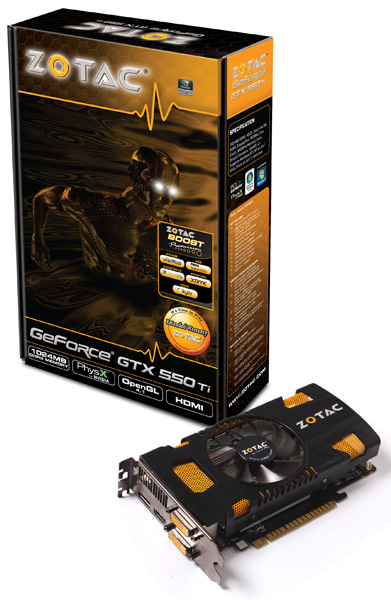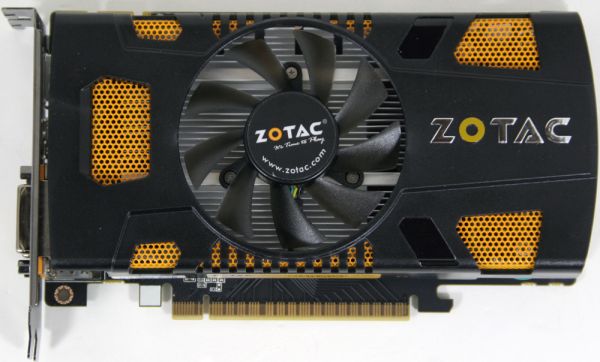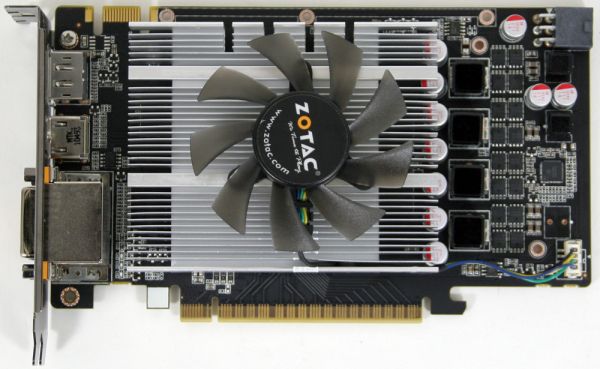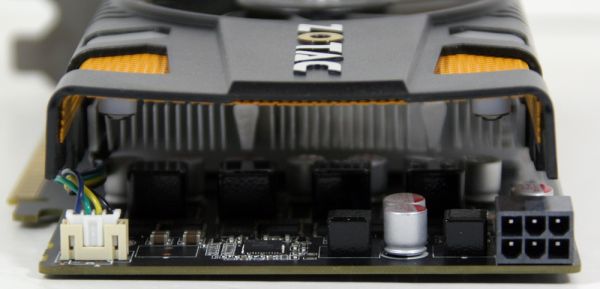NVIDIA's GeForce GTX 550 Ti: Coming Up Short At $150
by Ryan Smith on March 15, 2011 9:00 AM ESTMeet The Zotac GeForce GTX 550 Ti AMP Edition
As we stated at the start of this article, NVIDIA is not directly sampling GTX 550 Ti reference cards for this launch. Instead they have left it up to partners to do the sampling. Zotac in turn has provided us with their factory overclocked model, the GeForce GTX 550 Ti AMP, a custom design clocked at 1000MHz core and 1100MHz (4400MHz data rate) memory. We’ll be looking at performance at both stock GTX 550 and Zotac factory clocks.
The AMP is very similar in design to Zotac’s previous GTS 450 AMP card, which is not surprising given the near-perfect compatibility of the GTS 450 and GTX 550 designs. Zotac does not provide thermal/power data for their cards, but with the factory overclock we’d expect it to be a bit more than the 116W for the reference design.
At a hair under 7.5” and using a double-wide cooler design, the AMP is nearly ¾ of an inch shorter than the original GTS 450, reflecting the fact that NVIDIA’s partners often end up producing shorter cards. A simple shroud covers the card, which directs most of the airflow from the 74mm fan out the front and the rear of the card. If we remove the shroud we find a rectangular aluminum heatsink covering the GPU – the GDDR5 memory remains uncovered.
Power is supplied by a single rear-facing 6pin PCIe power socket, which provides more than enough power for a lower-power device such as the AMP. Zotac has outfitted the chip with Hynix GDDR5; 4 1Gb chips and 2 2Gb chips. All of them are rated for 5GHz operation, so even at 4.4GHz the AMP is running its memory below what the chips are capable of, not counting what the bus and GPU itself are capable of handling. Meanwhile as was the case with the GTS 450, a single SLI connector is provided for 2-way SLI.
A common theme with customized Zotac designs is support for additional display connectivity options beyond the NVIDIA reference design, and Zotac does not disappoint here. By shifting a DVI port to the 2nd slot, Zotac has outfitted the card with a full size DisplayPort, along with upgrading the HDMI port from mini to full size; they are still limited in terms of total displays by the GPU however, and even with 4 ports can only drive 2 displays at once. Zotac continues to be one of the only NVIDIA vendors we regularly see support DisplayPort, a sharp contrast from AMD & their partners who include it on virtually everything.

Rounding out the package is the usual collection of extras from Zotac. For hardware this means a molex-to-PCIe power adapter and a DVI-to-VGA adapter. Meanwhile on the software size Zotac continues to provide the Boost Premium package, which includes a collection of OEM & trial copies of various GPU-accelerated programs, including vReveal, Nero Vision, Cooliris, XBMC, and Kylo.
Zotac is pricing the card at $169 $155, $5 more than the NVIDIA MSRP for a basic card. With it comes a 2 year warranty, and a 3rd year is added upon registration.














79 Comments
View All Comments
HangFire - Tuesday, March 15, 2011 - link
Advertisers hate it when you see how competitive older offerings are with new stuff. So, little-used features like in DirectX 11 are used to force out comparisons with older cards that still deliver great frame rates and value, and cause users to not upgrade for a while.We won this battle for a while and AT had a few older cards it included in its benchmarks. Now its back to nothing but the latest.
morphologia - Tuesday, March 15, 2011 - link
"Nothing but the latest?" The 4870 and 4870X2 shown in this comparison are hardly current. I suppose the 4870 is less likely to outperform than the 4890 is, but the X2 makes an even stronger showing. Still does not make sense.Also, on an unrelated note, it looked like the 6990 was dropping out of various comparison scales without explanation. BattleForge 1680x1050, for example. 6990 dominated the 1920x1200 but was inexplicably absent from 1680x1050, instead the 580 topped that chart. What's up with that??
Ryan Smith - Tuesday, March 15, 2011 - link
The 6990 is not on any of the 1680 benchmarks. It's already CPU limited at 1920; at 1680 it's useless data since no one is going to use it at that resolution.Ryan Smith - Tuesday, March 15, 2011 - link
Due to the amount of time it takes to benchmark (and rebenchmark) GPUs, it's necessary to keep a truncated list, and from there not every card actually makes it in to the article (and this is why we have GPU Bench). As such I focus on the current and previous generation of GPUs, while throwing in a sampling of 3rd & 4th generation GPUs as a baseline.I specifically pick these older GPUs based on architecture and relative performance - the idea being that while we don't have every GPU in the system, if it's a few years old it's well established how other minor variations of that GPU perform relative to the one in our results database. So in this case the 4870 is in there both because it's easy to visualize where the 4850/4890 would be relative to it, and because it was easily the most popular 4800 card.
morphologia - Tuesday, March 15, 2011 - link
Seems like the 4870X2 was a bit of a spoiler, seeing as how it trumped a few of even the current generation, though it too was dropping in and out of the bar charts with no explanation. If you are going to include it at all, there should be more consistency. Otherwise it looks like ranking/stat doctoring.7Enigma - Thursday, March 17, 2011 - link
Ryan's already mentioned why. It's a dual GPU card at the time was likely not tested at the low resolutions this particular article used for these lower-end cards. Likely 1920X1200 (or 1080) was the lowest this card was benchmarked at. I applaud Anandtech for including the data they have, and as mentioned you can use Bench to compare to your hearts desire. Bottom line: it is unlikely someone is gaming at less than 24" resolutions with a 4870X2, and if they are they can use Bench for that particular purpose.These guys have enough to do without going back and retesting cards from years ago. I'm just glad the data is in there.
nwarawa - Tuesday, March 15, 2011 - link
I didn't hear much complaining about the GTX460 768MB all this time : all the reviews were heralding its value. Now we have an even less powerful GPU, and 768MB suddenly becomes an issue? The heck with that. 768MB should be the standard configuration for this card, with a MSRP of $129. If you want high resolutions with AA, you should be getting a more powerful GPU as well. Nvidia should use a 768MB model of the GTX550 to phase out the 768MB GTX460, keep the 1GB GTX460 for awhile, and encourage more brands to bin their GTX560Ti's and make some 2GB models (I know Palit/Gainward does one, but no availability where I live). An overclocked 2GB GTX560Ti would be handy in a handful of games (GTA4 immediately comes to mind), and would compete well with a 6950... leaving the GTX570 to dance with the 6970, and the GTX580 to maintain its single-chip lead.HangFire - Wednesday, March 16, 2011 - link
768MB did not suddenly become an issue. Previous AT articles on the two 460's have repeated warnings that 768MB would soon be not enough memory.Agreed that if you lower the price enough, 768MB becomes "enough" as you are unlikely to be driving high resolutions with the corresponding large numbers of in-memory high resolution textures with a low-end card. At moderate resolutions, 768MB is enough.
Belard - Tuesday, March 15, 2011 - link
(AMD - you still suck for naming the SLOWER 6870 cards to replace the 5870s etc)LOL - this would be FUNNY if it wasn't so sad.
1 - The "State of the art" 550 Ti (Total idiot) card is 0~5% faster than the the 1+ year old ATI 5770. Really, other than for reference - 1280x1024 scores are useless for todays monitors. $120~140 means buying a 20" 1920x1080 monitor, $160~200 is a 21~22" model. I'm missing the 1920x1200 since its not so bloody narrow. I'd love to see a 26~27" that does 2560 x 1600 on the market.
So when comparing the results for 1920x1080, which is a STANDARD for today. The 550 is sometimes 0~3 fps faster, sometimes slower.
2 - Price!? The 5770 is easily 1/3rd cheaper going for $100~125 vs, $150~160.
3 - Stupid model names!? GeForce was given to the series. So WTF is GFX good for? If the 550 is almost the bottom end... why not GTS like the GTS 450 or GTS 250? There is no consistency. It doesn't donate feature sets.
"TI" okay... What is the difference between a TI and a NON TI card? Oh yeah, the letters on the box and in bios, nothing else. Why bother?
We know Nivdia will most likely skip the 600 series (What happened to the 300s?) so they too can be "7s" with ATI. So well we see:
Nvidia GeForce GT 720 mx
Nvidia Geforce GTS 740 Pro
Nvidia Geforce GTX 780 Ultra
The Geforce 550 or "GF550" is ALL we need to know what the product is.
4 - ATI 6850... it should have been included in this benchmark since its in the same price range. Newegg as them for $150~180 ($160 avg). It would really show what people are paying for. The 6850 is about 10fps faster than the 5770/GF550
5 - GF 460-768 price is $130~160.. again, about 10fps faster than the GF550. But oh yeah, the 550 replaces the older and faster card. hate it when that hapens!
Think I'll hold on to my ATI 4670 until the AMD 7670/7770 comes out... I want the performance of a 5870/6950 with the heat/noise and power issues of a 5770 at a price under $180.
phoible_123 - Tuesday, March 15, 2011 - link
I find it kind of interesting that nVidia's price points for their mid-range cards are higher this time around.The GTX460 started at $220 IIRC (and had its price cut pretty quickly), while the GTX560 is $259. The price for the 460 was pretty killer, but by the time the 560 came out, the pricing was pretty ho hum. If they had launched it at the same price level as the 460, AMD wouldn't have been able to compete. Granted, I'm sure they priced it that way to keep margins high, but this is a process improvement rather than an all-new chip (basically it's the third-gen gf100)...
The GTS450 was $130, while the GTX550 "TI" is $150. And when the GTS450 came out, the value prop wasn't that good (when compared to the 460). It's like half the card for only a little less money.
I recently picked up a GTX460 768MB for $90 after rebates.
It's kind of like the radeon 48xx vs 57xx comparison (less card for more money).